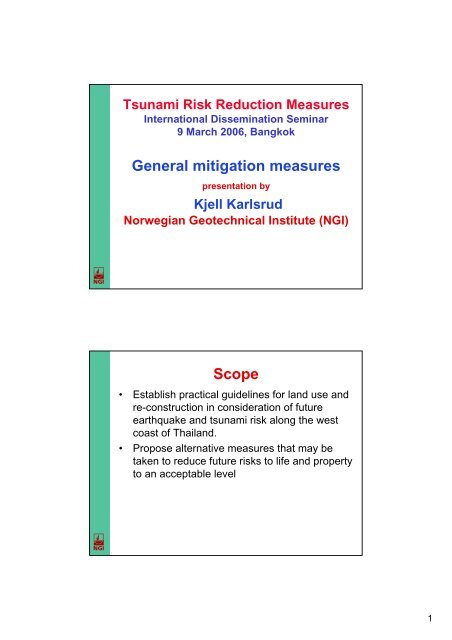General mitigation measures Scope - CCOP
General mitigation measures Scope - CCOP
General mitigation measures Scope - CCOP
You also want an ePaper? Increase the reach of your titles
YUMPU automatically turns print PDFs into web optimized ePapers that Google loves.
Tsunami Risk Reduction Measures<br />
International Dissemination Seminar<br />
9 March 2006, Bangkok<br />
<strong>General</strong> <strong>mitigation</strong> <strong>measures</strong><br />
presentation by<br />
Kjell Karlsrud<br />
Norwegian Geotechnical Institute (NGI)<br />
<strong>Scope</strong><br />
• Establish practical guidelines for land use and<br />
re-construction in consideration of future<br />
earthquake and tsunami risk along the west<br />
coast of Thailand.<br />
• Propose alternative <strong>measures</strong> that may be<br />
taken to reduce future risks to life and property<br />
to an acceptable level<br />
1
Conclusions from risk assessment<br />
• The potential for a new megathrust M 9+ event<br />
will after 100-200 years give highly<br />
unacceptable risk<br />
Potential for very large consequences,<br />
possibly even worse than 2004<br />
It should be the responsibility and<br />
duty of present generations to take<br />
steps to minimize consequences of<br />
such long term events<br />
Types of <strong>mitigation</strong> <strong>measures</strong><br />
• Awareness building and warning systems<br />
• Land Use and Master Plans<br />
• Building Codes<br />
• Site and Project Planning<br />
• Functional network of escape routes to safe<br />
places<br />
• Establishment of safe places (elevated land,<br />
buildings or other structures)<br />
• Physical protection barriers<br />
2
Warning systems are not covered<br />
by this study, but:<br />
• Considerable efforts have been made in<br />
Thailand as well as regionally<br />
• It is important to have proper understanding of<br />
future tsunami scenarios<br />
• Look for simplicity-”what is good enough now”<br />
• In the long term new and improved technology<br />
will come!<br />
How to ensure<br />
lasting awareness is<br />
a key issue<br />
3
Lasting awareness <strong>measures</strong><br />
• ”Monuments” which also could be part of<br />
protection structure<br />
• Curriculum in schools?<br />
• National tsunami or hazard day?<br />
Detailed <strong>measures</strong> must be suited<br />
to the local setting<br />
Memorial wall- Hiro village, Japan<br />
4
Example of memorial under<br />
construction in Thailand<br />
Memorials must cover all areas potentially affected<br />
5
Masterplans and regulations may:<br />
• Prohibit developments in high risk zones<br />
• Ban buildings that represent high vulnerability<br />
or hazardous facilities, and avoid important<br />
infrastructure in the most hazard-prone areas<br />
• Set requirements (in master plans, building<br />
codes etc) to reduce vulnerability in hazard<br />
prone areas<br />
Building <strong>measures</strong><br />
H max<br />
• Upper floor safe from tsunami surge<br />
• Easily accessible escape to safe floor<br />
• Bedrooms at safe level (H max )<br />
• Main structure shall not collapse<br />
• Front and back walls at ground levels may be<br />
designed to collapse<br />
6
Tsunami forces against a building<br />
When a surging<br />
tsunami hits a<br />
building, the force<br />
might appear as<br />
a slamming force<br />
with relatively<br />
high intensity and<br />
short duration<br />
Farmers house typical Ruen<br />
Krueng Pook<br />
7
Elevated areas for housing<br />
L 1<br />
L 2<br />
H<br />
•Required height in relation to tsunami<br />
inundation level<br />
•Fill from dredging or land pits<br />
•Can also function as escape pods<br />
Protection barriers<br />
• Dikes<br />
• Vertical seawalls<br />
• Moles or breakwaters in the sea<br />
8
Dike or sand dune type barrier<br />
•Practical upper limit of height?<br />
•Core and protection material<br />
•Outlets through dike<br />
•Limited overtopping may be acceptable<br />
Example of dike built to protect<br />
Hiro village Japan in 1854<br />
After Ohta,2005<br />
9
Protection dike- Hiro village<br />
After Ohta, 2005<br />
Vertical seawalls<br />
• Practical upper limit of height?<br />
• Requires arrangement for outlet of<br />
normal run-off from areas behind.<br />
• Limited overtopping may be acceptable<br />
10
Ancient portuguese fortification- The city<br />
walls of El Jadida, Morocco<br />
The Patong<br />
Bay could in<br />
principle be<br />
protected by<br />
breakwater,<br />
but….<br />
11
Model:<br />
Breakwater across the bay<br />
(Case of Patong City)<br />
Potential breakwater along the Patong City beach,<br />
approximately 1 km offcoast, with a 100 m wide<br />
opening<br />
12

















